Disorders, Diagnostic Tests, and Nursing Interventions Overview
VerifiedAdded on 2021/12/27
|10
|1850
|23
Homework Assignment
AI Summary
This assignment delves into various aspects of healthcare, including common disorders and conditions across multiple body systems, such as the musculoskeletal, skin, cardiovascular, respiratory, gastrointestinal, ear, eye, nervous, endocrine, urinary, and reproductive systems. For each system, the assignment lists six common disorders or conditions. It explores diagnostic tests, such as incentive spirometry and peak flow, and their role in diagnosing conditions like asthma and chronic obstructive pulmonary disease. The assignment also defines and differentiates critical, creative, and problem-solving thinking, and discusses nursing standards for supporting individuals with disabilities, as well as issues nurses need to consider when supporting patients with diabetes and constipation. Furthermore, it includes tables summarizing diagnostic tests for common conditions and nursing interventions for reproductive and urinary system disorders. A case study involving a patient with a blocked urinary catheter provides an opportunity to apply conflict resolution strategies and identify appropriate reporting procedures. The assignment concludes with a list of references.
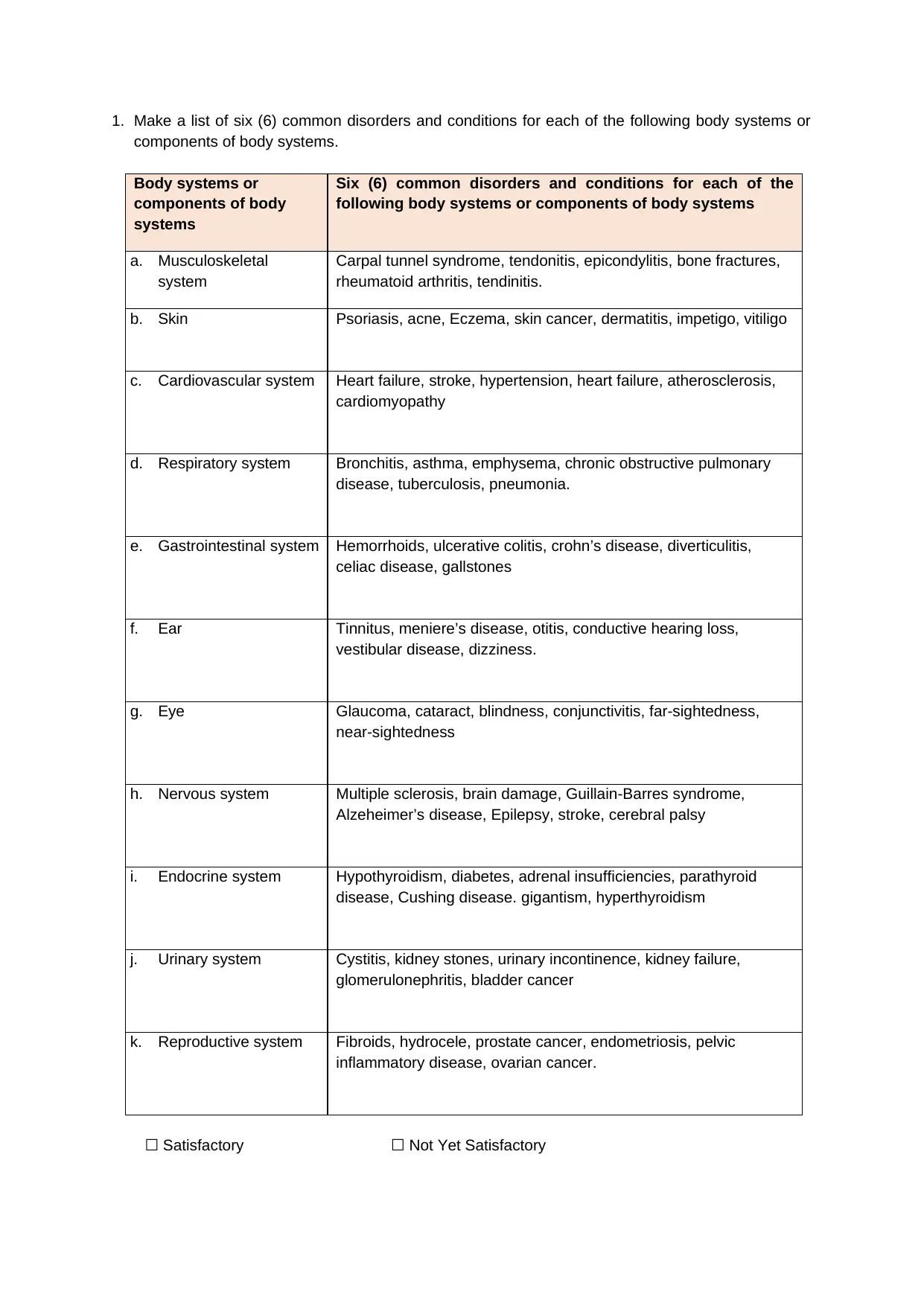
1. Make a list of six (6) common disorders and conditions for each of the following body systems or
components of body systems.
Body systems or
components of body
systems
Six (6) common disorders and conditions for each of the
following body systems or components of body systems
a. Musculoskeletal
system
Carpal tunnel syndrome, tendonitis, epicondylitis, bone fractures,
rheumatoid arthritis, tendinitis.
b. Skin Psoriasis, acne, Eczema, skin cancer, dermatitis, impetigo, vitiligo
c. Cardiovascular system Heart failure, stroke, hypertension, heart failure, atherosclerosis,
cardiomyopathy
d. Respiratory system Bronchitis, asthma, emphysema, chronic obstructive pulmonary
disease, tuberculosis, pneumonia.
e. Gastrointestinal system Hemorrhoids, ulcerative colitis, crohn’s disease, diverticulitis,
celiac disease, gallstones
f. Ear Tinnitus, meniere’s disease, otitis, conductive hearing loss,
vestibular disease, dizziness.
g. Eye Glaucoma, cataract, blindness, conjunctivitis, far-sightedness,
near-sightedness
h. Nervous system Multiple sclerosis, brain damage, Guillain-Barres syndrome,
Alzeheimer’s disease, Epilepsy, stroke, cerebral palsy
i. Endocrine system Hypothyroidism, diabetes, adrenal insufficiencies, parathyroid
disease, Cushing disease. gigantism, hyperthyroidism
j. Urinary system Cystitis, kidney stones, urinary incontinence, kidney failure,
glomerulonephritis, bladder cancer
k. Reproductive system Fibroids, hydrocele, prostate cancer, endometriosis, pelvic
inflammatory disease, ovarian cancer.
Satisfactory☐ Not Yet Satisfactory☐
components of body systems.
Body systems or
components of body
systems
Six (6) common disorders and conditions for each of the
following body systems or components of body systems
a. Musculoskeletal
system
Carpal tunnel syndrome, tendonitis, epicondylitis, bone fractures,
rheumatoid arthritis, tendinitis.
b. Skin Psoriasis, acne, Eczema, skin cancer, dermatitis, impetigo, vitiligo
c. Cardiovascular system Heart failure, stroke, hypertension, heart failure, atherosclerosis,
cardiomyopathy
d. Respiratory system Bronchitis, asthma, emphysema, chronic obstructive pulmonary
disease, tuberculosis, pneumonia.
e. Gastrointestinal system Hemorrhoids, ulcerative colitis, crohn’s disease, diverticulitis,
celiac disease, gallstones
f. Ear Tinnitus, meniere’s disease, otitis, conductive hearing loss,
vestibular disease, dizziness.
g. Eye Glaucoma, cataract, blindness, conjunctivitis, far-sightedness,
near-sightedness
h. Nervous system Multiple sclerosis, brain damage, Guillain-Barres syndrome,
Alzeheimer’s disease, Epilepsy, stroke, cerebral palsy
i. Endocrine system Hypothyroidism, diabetes, adrenal insufficiencies, parathyroid
disease, Cushing disease. gigantism, hyperthyroidism
j. Urinary system Cystitis, kidney stones, urinary incontinence, kidney failure,
glomerulonephritis, bladder cancer
k. Reproductive system Fibroids, hydrocele, prostate cancer, endometriosis, pelvic
inflammatory disease, ovarian cancer.
Satisfactory☐ Not Yet Satisfactory☐
Paraphrase This Document
Need a fresh take? Get an instant paraphrase of this document with our AI Paraphraser
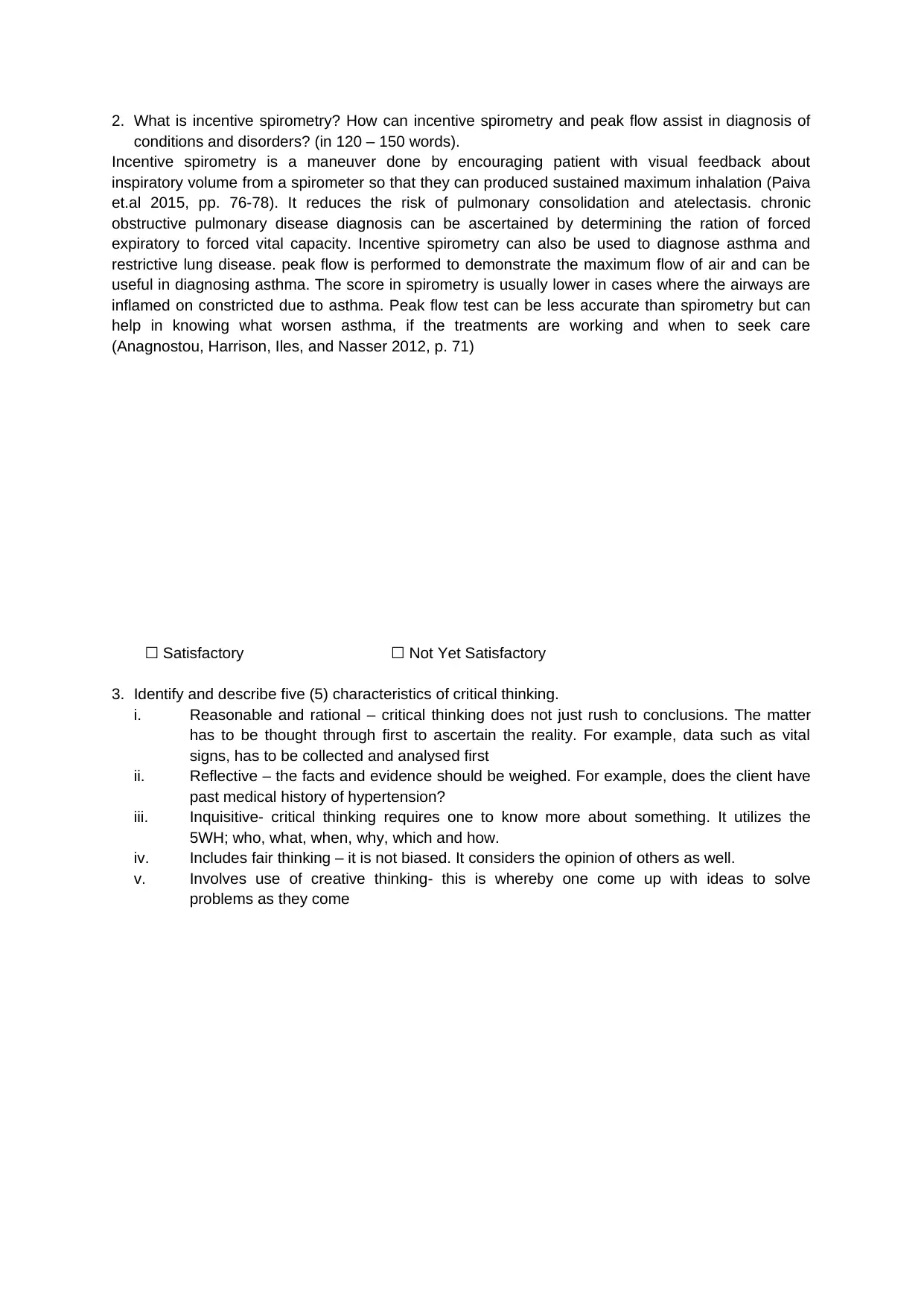
2. What is incentive spirometry? How can incentive spirometry and peak flow assist in diagnosis of
conditions and disorders? (in 120 – 150 words).
Incentive spirometry is a maneuver done by encouraging patient with visual feedback about
inspiratory volume from a spirometer so that they can produced sustained maximum inhalation (Paiva
et.al 2015, pp. 76-78). It reduces the risk of pulmonary consolidation and atelectasis. chronic
obstructive pulmonary disease diagnosis can be ascertained by determining the ration of forced
expiratory to forced vital capacity. Incentive spirometry can also be used to diagnose asthma and
restrictive lung disease. peak flow is performed to demonstrate the maximum flow of air and can be
useful in diagnosing asthma. The score in spirometry is usually lower in cases where the airways are
inflamed on constricted due to asthma. Peak flow test can be less accurate than spirometry but can
help in knowing what worsen asthma, if the treatments are working and when to seek care
(Anagnostou, Harrison, Iles, and Nasser 2012, p. 71)
Satisfactory☐ Not Yet Satisfactory☐
3. Identify and describe five (5) characteristics of critical thinking.
i. Reasonable and rational – critical thinking does not just rush to conclusions. The matter
has to be thought through first to ascertain the reality. For example, data such as vital
signs, has to be collected and analysed first
ii. Reflective – the facts and evidence should be weighed. For example, does the client have
past medical history of hypertension?
iii. Inquisitive- critical thinking requires one to know more about something. It utilizes the
5WH; who, what, when, why, which and how.
iv. Includes fair thinking – it is not biased. It considers the opinion of others as well.
v. Involves use of creative thinking- this is whereby one come up with ideas to solve
problems as they come
conditions and disorders? (in 120 – 150 words).
Incentive spirometry is a maneuver done by encouraging patient with visual feedback about
inspiratory volume from a spirometer so that they can produced sustained maximum inhalation (Paiva
et.al 2015, pp. 76-78). It reduces the risk of pulmonary consolidation and atelectasis. chronic
obstructive pulmonary disease diagnosis can be ascertained by determining the ration of forced
expiratory to forced vital capacity. Incentive spirometry can also be used to diagnose asthma and
restrictive lung disease. peak flow is performed to demonstrate the maximum flow of air and can be
useful in diagnosing asthma. The score in spirometry is usually lower in cases where the airways are
inflamed on constricted due to asthma. Peak flow test can be less accurate than spirometry but can
help in knowing what worsen asthma, if the treatments are working and when to seek care
(Anagnostou, Harrison, Iles, and Nasser 2012, p. 71)
Satisfactory☐ Not Yet Satisfactory☐
3. Identify and describe five (5) characteristics of critical thinking.
i. Reasonable and rational – critical thinking does not just rush to conclusions. The matter
has to be thought through first to ascertain the reality. For example, data such as vital
signs, has to be collected and analysed first
ii. Reflective – the facts and evidence should be weighed. For example, does the client have
past medical history of hypertension?
iii. Inquisitive- critical thinking requires one to know more about something. It utilizes the
5WH; who, what, when, why, which and how.
iv. Includes fair thinking – it is not biased. It considers the opinion of others as well.
v. Involves use of creative thinking- this is whereby one come up with ideas to solve
problems as they come

Satisfactory☐ Not Yet Satisfactory☐
⊘ This is a preview!⊘
Do you want full access?
Subscribe today to unlock all pages.

Trusted by 1+ million students worldwide
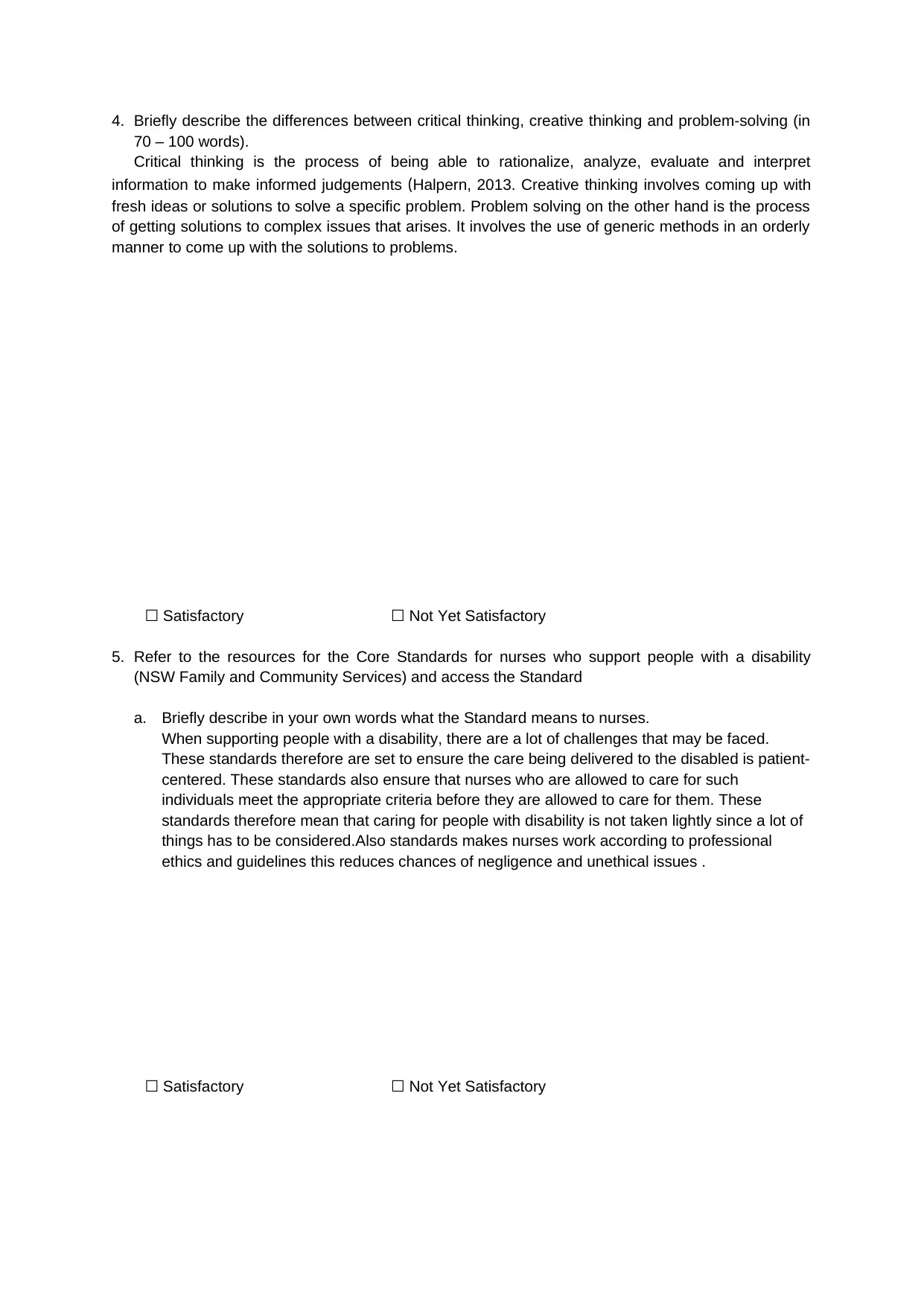
4. Briefly describe the differences between critical thinking, creative thinking and problem-solving (in
70 – 100 words).
Critical thinking is the process of being able to rationalize, analyze, evaluate and interpret
information to make informed judgements (Halpern, 2013. Creative thinking involves coming up with
fresh ideas or solutions to solve a specific problem. Problem solving on the other hand is the process
of getting solutions to complex issues that arises. It involves the use of generic methods in an orderly
manner to come up with the solutions to problems.
Satisfactory☐ Not Yet Satisfactory☐
5. Refer to the resources for the Core Standards for nurses who support people with a disability
(NSW Family and Community Services) and access the Standard
a. Briefly describe in your own words what the Standard means to nurses.
When supporting people with a disability, there are a lot of challenges that may be faced.
These standards therefore are set to ensure the care being delivered to the disabled is patient-
centered. These standards also ensure that nurses who are allowed to care for such
individuals meet the appropriate criteria before they are allowed to care for them. These
standards therefore mean that caring for people with disability is not taken lightly since a lot of
things has to be considered.Also standards makes nurses work according to professional
ethics and guidelines this reduces chances of negligence and unethical issues .
Satisfactory☐ Not Yet Satisfactory☐
70 – 100 words).
Critical thinking is the process of being able to rationalize, analyze, evaluate and interpret
information to make informed judgements (Halpern, 2013. Creative thinking involves coming up with
fresh ideas or solutions to solve a specific problem. Problem solving on the other hand is the process
of getting solutions to complex issues that arises. It involves the use of generic methods in an orderly
manner to come up with the solutions to problems.
Satisfactory☐ Not Yet Satisfactory☐
5. Refer to the resources for the Core Standards for nurses who support people with a disability
(NSW Family and Community Services) and access the Standard
a. Briefly describe in your own words what the Standard means to nurses.
When supporting people with a disability, there are a lot of challenges that may be faced.
These standards therefore are set to ensure the care being delivered to the disabled is patient-
centered. These standards also ensure that nurses who are allowed to care for such
individuals meet the appropriate criteria before they are allowed to care for them. These
standards therefore mean that caring for people with disability is not taken lightly since a lot of
things has to be considered.Also standards makes nurses work according to professional
ethics and guidelines this reduces chances of negligence and unethical issues .
Satisfactory☐ Not Yet Satisfactory☐
Paraphrase This Document
Need a fresh take? Get an instant paraphrase of this document with our AI Paraphraser
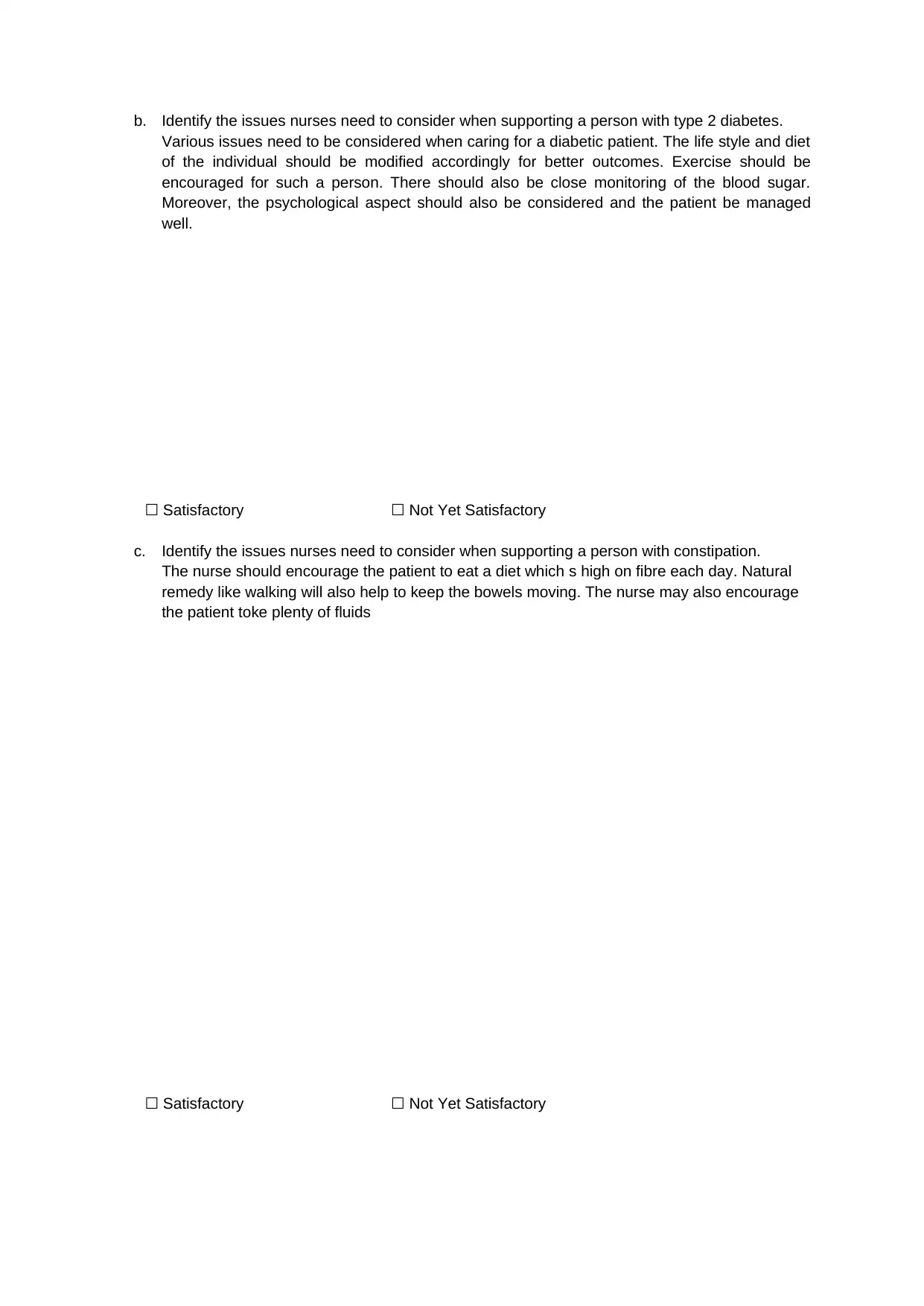
b. Identify the issues nurses need to consider when supporting a person with type 2 diabetes.
Various issues need to be considered when caring for a diabetic patient. The life style and diet
of the individual should be modified accordingly for better outcomes. Exercise should be
encouraged for such a person. There should also be close monitoring of the blood sugar.
Moreover, the psychological aspect should also be considered and the patient be managed
well.
Satisfactory☐ Not Yet Satisfactory☐
c. Identify the issues nurses need to consider when supporting a person with constipation.
The nurse should encourage the patient to eat a diet which s high on fibre each day. Natural
remedy like walking will also help to keep the bowels moving. The nurse may also encourage
the patient toke plenty of fluids
Satisfactory☐ Not Yet Satisfactory☐
Various issues need to be considered when caring for a diabetic patient. The life style and diet
of the individual should be modified accordingly for better outcomes. Exercise should be
encouraged for such a person. There should also be close monitoring of the blood sugar.
Moreover, the psychological aspect should also be considered and the patient be managed
well.
Satisfactory☐ Not Yet Satisfactory☐
c. Identify the issues nurses need to consider when supporting a person with constipation.
The nurse should encourage the patient to eat a diet which s high on fibre each day. Natural
remedy like walking will also help to keep the bowels moving. The nurse may also encourage
the patient toke plenty of fluids
Satisfactory☐ Not Yet Satisfactory☐
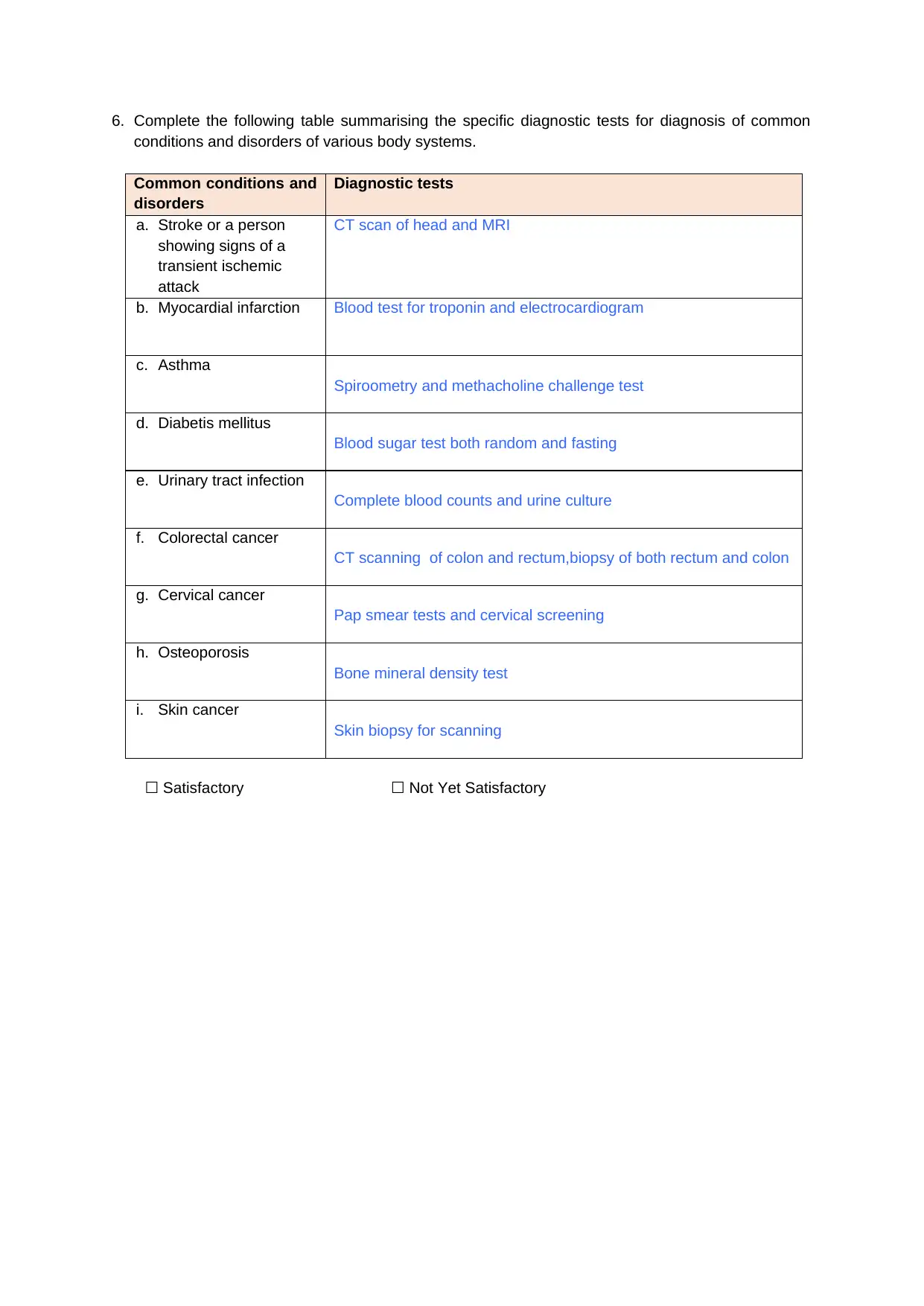
6. Complete the following table summarising the specific diagnostic tests for diagnosis of common
conditions and disorders of various body systems.
Common conditions and
disorders
Diagnostic tests
a. Stroke or a person
showing signs of a
transient ischemic
attack
CT scan of head and MRI
b. Myocardial infarction Blood test for troponin and electrocardiogram
c. Asthma
Spiroometry and methacholine challenge test
d. Diabetis mellitus
Blood sugar test both random and fasting
e. Urinary tract infection
Complete blood counts and urine culture
f. Colorectal cancer
CT scanning of colon and rectum,biopsy of both rectum and colon
g. Cervical cancer
Pap smear tests and cervical screening
h. Osteoporosis
Bone mineral density test
i. Skin cancer
Skin biopsy for scanning
Satisfactory☐ Not Yet Satisfactory☐
conditions and disorders of various body systems.
Common conditions and
disorders
Diagnostic tests
a. Stroke or a person
showing signs of a
transient ischemic
attack
CT scan of head and MRI
b. Myocardial infarction Blood test for troponin and electrocardiogram
c. Asthma
Spiroometry and methacholine challenge test
d. Diabetis mellitus
Blood sugar test both random and fasting
e. Urinary tract infection
Complete blood counts and urine culture
f. Colorectal cancer
CT scanning of colon and rectum,biopsy of both rectum and colon
g. Cervical cancer
Pap smear tests and cervical screening
h. Osteoporosis
Bone mineral density test
i. Skin cancer
Skin biopsy for scanning
Satisfactory☐ Not Yet Satisfactory☐
⊘ This is a preview!⊘
Do you want full access?
Subscribe today to unlock all pages.

Trusted by 1+ million students worldwide
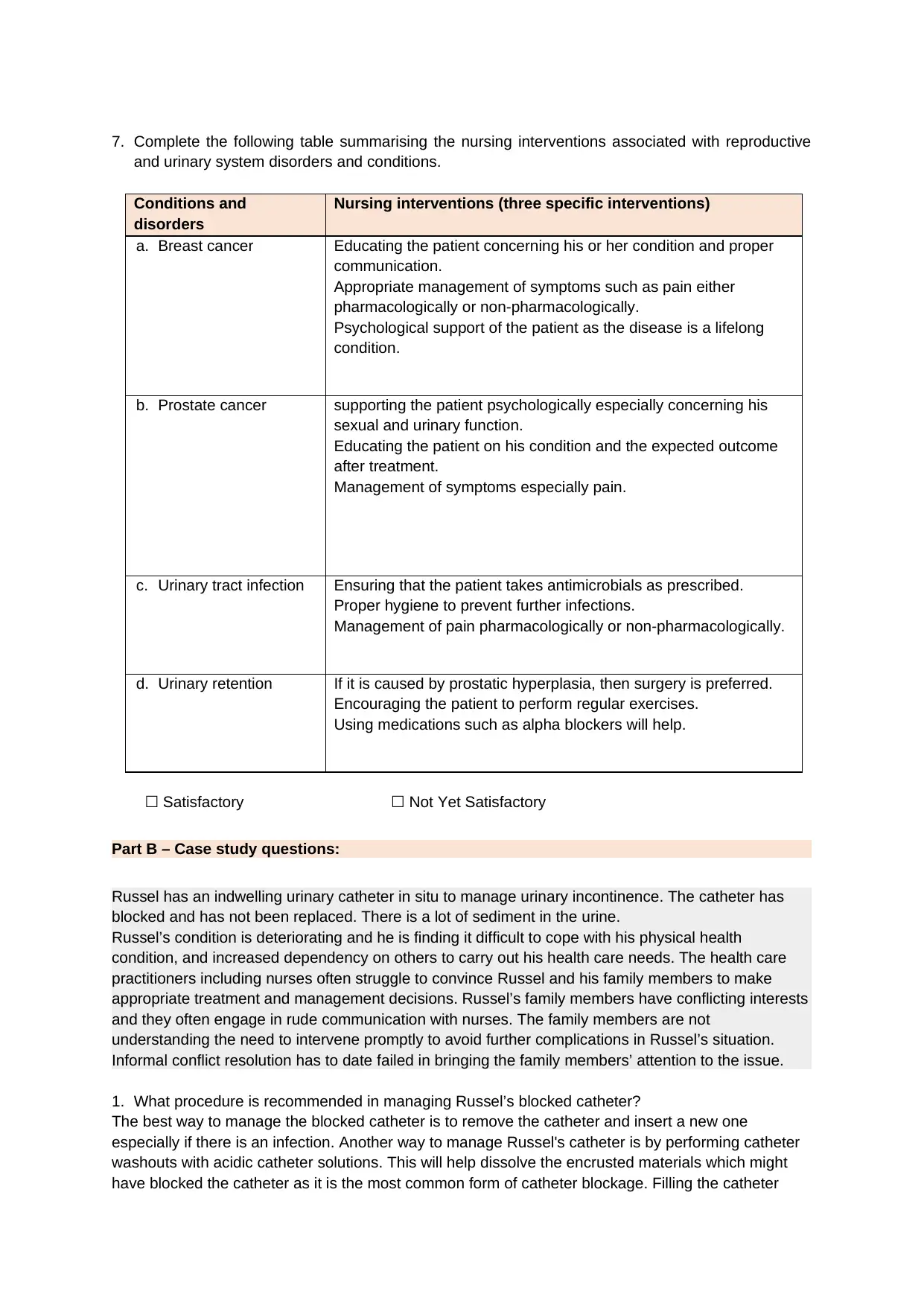
7. Complete the following table summarising the nursing interventions associated with reproductive
and urinary system disorders and conditions.
Conditions and
disorders
Nursing interventions (three specific interventions)
a. Breast cancer Educating the patient concerning his or her condition and proper
communication.
Appropriate management of symptoms such as pain either
pharmacologically or non-pharmacologically.
Psychological support of the patient as the disease is a lifelong
condition.
b. Prostate cancer supporting the patient psychologically especially concerning his
sexual and urinary function.
Educating the patient on his condition and the expected outcome
after treatment.
Management of symptoms especially pain.
c. Urinary tract infection Ensuring that the patient takes antimicrobials as prescribed.
Proper hygiene to prevent further infections.
Management of pain pharmacologically or non-pharmacologically.
d. Urinary retention If it is caused by prostatic hyperplasia, then surgery is preferred.
Encouraging the patient to perform regular exercises.
Using medications such as alpha blockers will help.
Satisfactory☐ Not Yet Satisfactory☐
Part B – Case study questions:
Russel has an indwelling urinary catheter in situ to manage urinary incontinence. The catheter has
blocked and has not been replaced. There is a lot of sediment in the urine.
Russel’s condition is deteriorating and he is finding it difficult to cope with his physical health
condition, and increased dependency on others to carry out his health care needs. The health care
practitioners including nurses often struggle to convince Russel and his family members to make
appropriate treatment and management decisions. Russel’s family members have conflicting interests
and they often engage in rude communication with nurses. The family members are not
understanding the need to intervene promptly to avoid further complications in Russel’s situation.
Informal conflict resolution has to date failed in bringing the family members’ attention to the issue.
1. What procedure is recommended in managing Russel’s blocked catheter?
The best way to manage the blocked catheter is to remove the catheter and insert a new one
especially if there is an infection. Another way to manage Russel's catheter is by performing catheter
washouts with acidic catheter solutions. This will help dissolve the encrusted materials which might
have blocked the catheter as it is the most common form of catheter blockage. Filling the catheter
and urinary system disorders and conditions.
Conditions and
disorders
Nursing interventions (three specific interventions)
a. Breast cancer Educating the patient concerning his or her condition and proper
communication.
Appropriate management of symptoms such as pain either
pharmacologically or non-pharmacologically.
Psychological support of the patient as the disease is a lifelong
condition.
b. Prostate cancer supporting the patient psychologically especially concerning his
sexual and urinary function.
Educating the patient on his condition and the expected outcome
after treatment.
Management of symptoms especially pain.
c. Urinary tract infection Ensuring that the patient takes antimicrobials as prescribed.
Proper hygiene to prevent further infections.
Management of pain pharmacologically or non-pharmacologically.
d. Urinary retention If it is caused by prostatic hyperplasia, then surgery is preferred.
Encouraging the patient to perform regular exercises.
Using medications such as alpha blockers will help.
Satisfactory☐ Not Yet Satisfactory☐
Part B – Case study questions:
Russel has an indwelling urinary catheter in situ to manage urinary incontinence. The catheter has
blocked and has not been replaced. There is a lot of sediment in the urine.
Russel’s condition is deteriorating and he is finding it difficult to cope with his physical health
condition, and increased dependency on others to carry out his health care needs. The health care
practitioners including nurses often struggle to convince Russel and his family members to make
appropriate treatment and management decisions. Russel’s family members have conflicting interests
and they often engage in rude communication with nurses. The family members are not
understanding the need to intervene promptly to avoid further complications in Russel’s situation.
Informal conflict resolution has to date failed in bringing the family members’ attention to the issue.
1. What procedure is recommended in managing Russel’s blocked catheter?
The best way to manage the blocked catheter is to remove the catheter and insert a new one
especially if there is an infection. Another way to manage Russel's catheter is by performing catheter
washouts with acidic catheter solutions. This will help dissolve the encrusted materials which might
have blocked the catheter as it is the most common form of catheter blockage. Filling the catheter
Paraphrase This Document
Need a fresh take? Get an instant paraphrase of this document with our AI Paraphraser
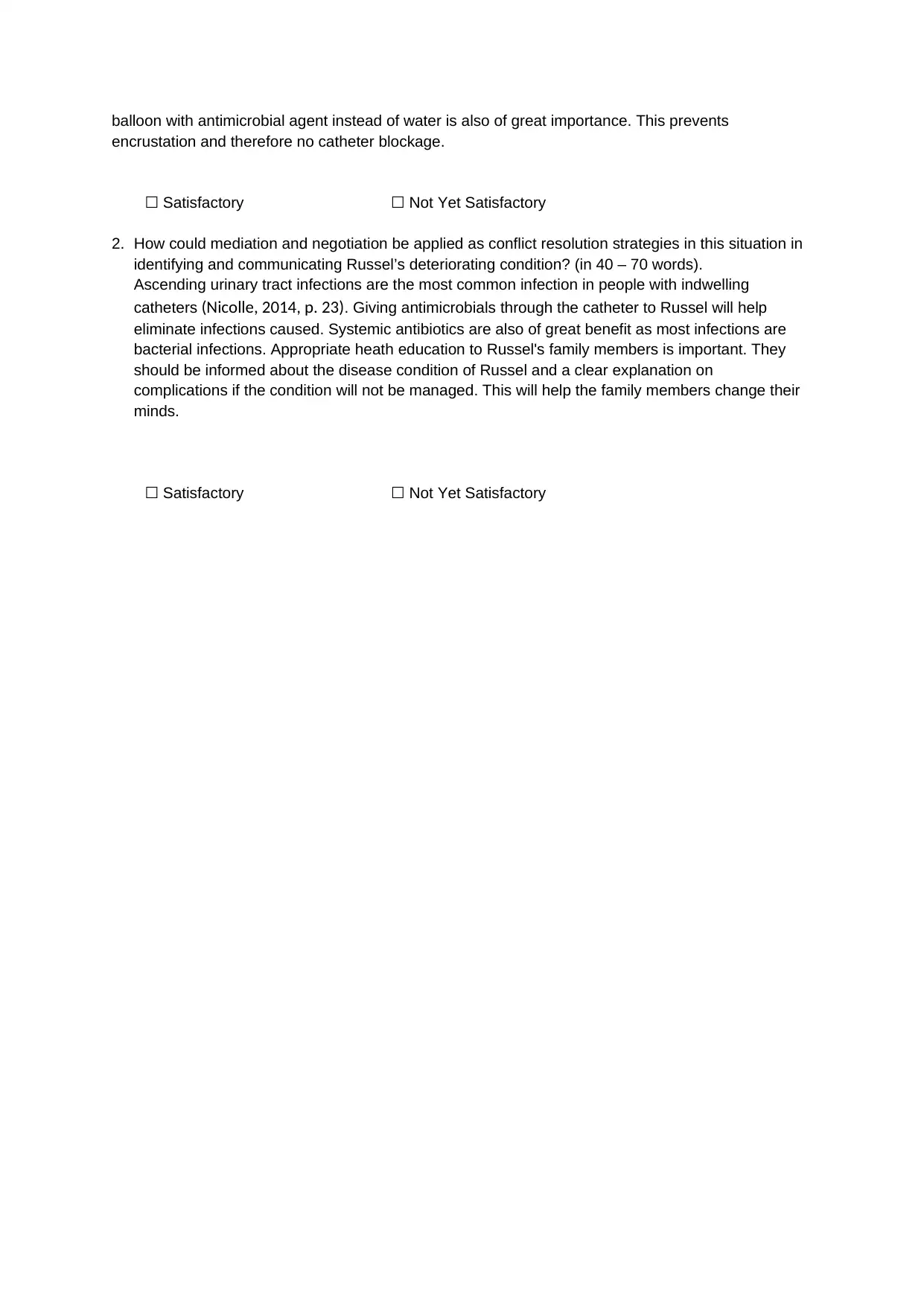
balloon with antimicrobial agent instead of water is also of great importance. This prevents
encrustation and therefore no catheter blockage.
Satisfactory☐ Not Yet Satisfactory☐
2. How could mediation and negotiation be applied as conflict resolution strategies in this situation in
identifying and communicating Russel’s deteriorating condition? (in 40 – 70 words).
Ascending urinary tract infections are the most common infection in people with indwelling
catheters (Nicolle, 2014, p. 23). Giving antimicrobials through the catheter to Russel will help
eliminate infections caused. Systemic antibiotics are also of great benefit as most infections are
bacterial infections. Appropriate heath education to Russel's family members is important. They
should be informed about the disease condition of Russel and a clear explanation on
complications if the condition will not be managed. This will help the family members change their
minds.
Satisfactory☐ Not Yet Satisfactory☐
encrustation and therefore no catheter blockage.
Satisfactory☐ Not Yet Satisfactory☐
2. How could mediation and negotiation be applied as conflict resolution strategies in this situation in
identifying and communicating Russel’s deteriorating condition? (in 40 – 70 words).
Ascending urinary tract infections are the most common infection in people with indwelling
catheters (Nicolle, 2014, p. 23). Giving antimicrobials through the catheter to Russel will help
eliminate infections caused. Systemic antibiotics are also of great benefit as most infections are
bacterial infections. Appropriate heath education to Russel's family members is important. They
should be informed about the disease condition of Russel and a clear explanation on
complications if the condition will not be managed. This will help the family members change their
minds.
Satisfactory☐ Not Yet Satisfactory☐

3. Who will you promptly report concerns to in relation to the deteriorating client?
The closest family member
Satisfactory☐ Not Yet Satisfactory☐
The closest family member
Satisfactory☐ Not Yet Satisfactory☐
⊘ This is a preview!⊘
Do you want full access?
Subscribe today to unlock all pages.

Trusted by 1+ million students worldwide
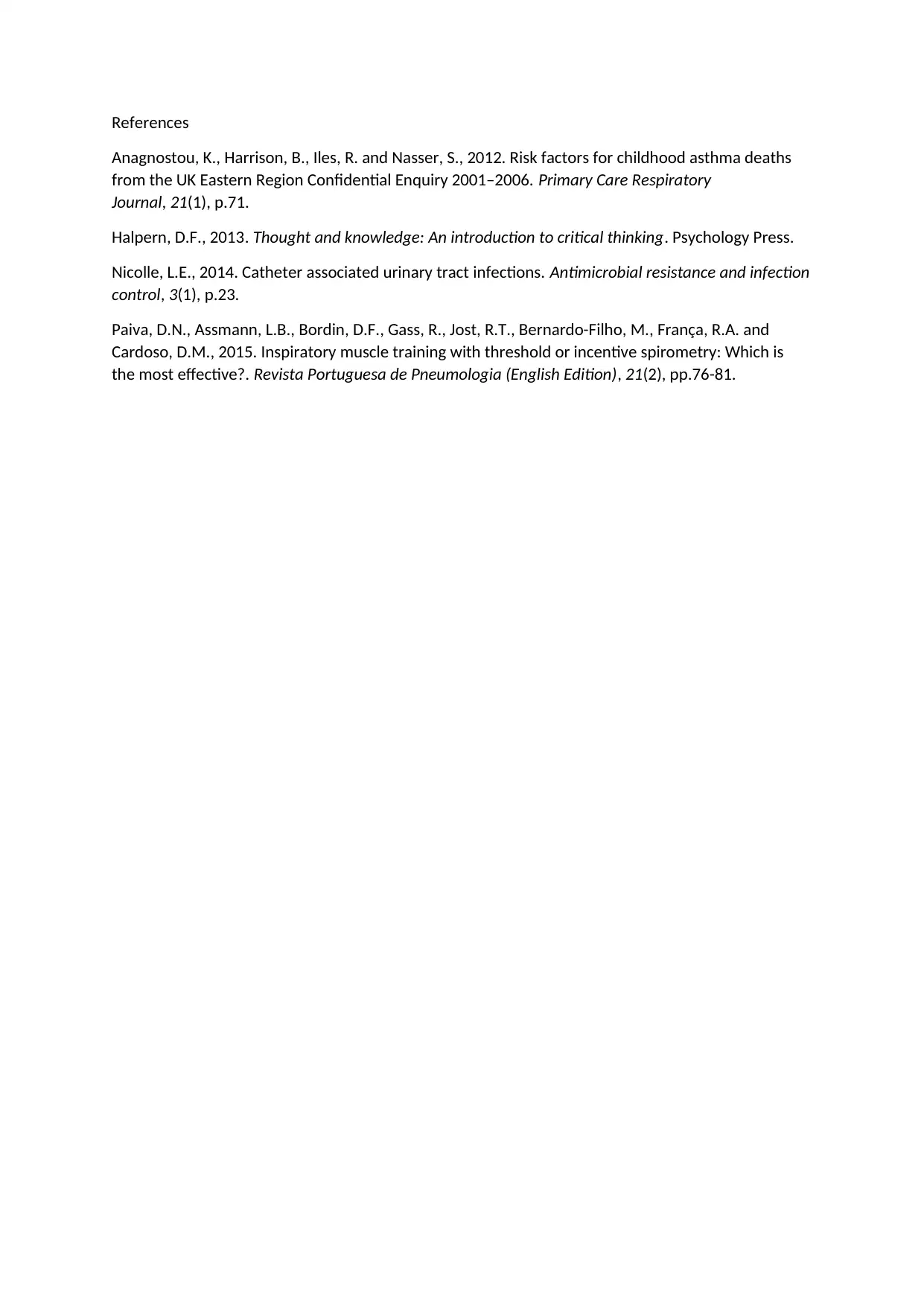
References
Anagnostou, K., Harrison, B., Iles, R. and Nasser, S., 2012. Risk factors for childhood asthma deaths
from the UK Eastern Region Confidential Enquiry 2001–2006. Primary Care Respiratory
Journal, 21(1), p.71.
Halpern, D.F., 2013. Thought and knowledge: An introduction to critical thinking. Psychology Press.
Nicolle, L.E., 2014. Catheter associated urinary tract infections. Antimicrobial resistance and infection
control, 3(1), p.23.
Paiva, D.N., Assmann, L.B., Bordin, D.F., Gass, R., Jost, R.T., Bernardo-Filho, M., França, R.A. and
Cardoso, D.M., 2015. Inspiratory muscle training with threshold or incentive spirometry: Which is
the most effective?. Revista Portuguesa de Pneumologia (English Edition), 21(2), pp.76-81.
Anagnostou, K., Harrison, B., Iles, R. and Nasser, S., 2012. Risk factors for childhood asthma deaths
from the UK Eastern Region Confidential Enquiry 2001–2006. Primary Care Respiratory
Journal, 21(1), p.71.
Halpern, D.F., 2013. Thought and knowledge: An introduction to critical thinking. Psychology Press.
Nicolle, L.E., 2014. Catheter associated urinary tract infections. Antimicrobial resistance and infection
control, 3(1), p.23.
Paiva, D.N., Assmann, L.B., Bordin, D.F., Gass, R., Jost, R.T., Bernardo-Filho, M., França, R.A. and
Cardoso, D.M., 2015. Inspiratory muscle training with threshold or incentive spirometry: Which is
the most effective?. Revista Portuguesa de Pneumologia (English Edition), 21(2), pp.76-81.
1 out of 10
Related Documents
Your All-in-One AI-Powered Toolkit for Academic Success.
+13062052269
info@desklib.com
Available 24*7 on WhatsApp / Email
![[object Object]](/_next/static/media/star-bottom.7253800d.svg)
Unlock your academic potential
Copyright © 2020–2025 A2Z Services. All Rights Reserved. Developed and managed by ZUCOL.


